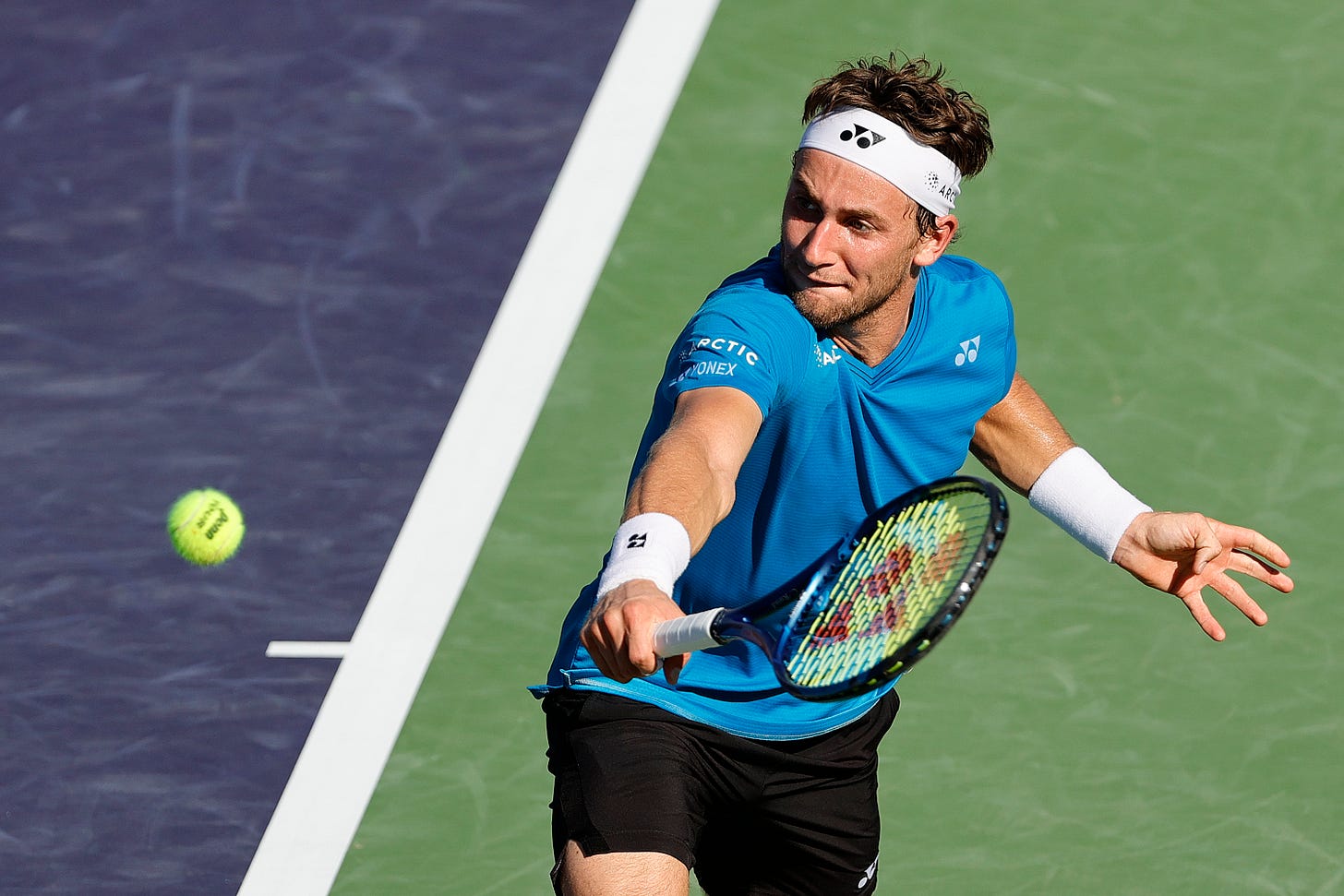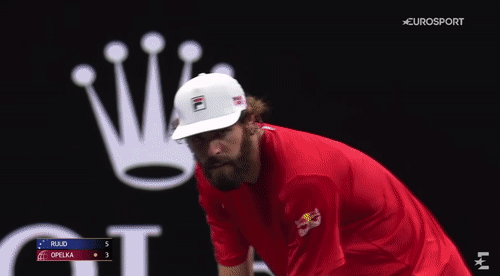Casper Ruud has had the best season of his young career in 2021, finishing the season ranked No.8, qualifying for the ATP Finals, and winning 5 titles. Despite being widely labelled as ‘just’ a clay courter for most of the past few years, the young Norwegian has posted some impressive hard court results recently, including a first ATP hard court title in San Diego (beating Murray, Sonego, Dimitrov, Norrie), and a run to the Semi’s of the ATP Finals. The start of his season was far from ideal, having to retire from the Australian Open with a stomach injury, but from Monte Carlo onwards Ruud consistently impressed.
Clay is always going to be Ruud’s best surface and Casper looked increasingly impressive on the red stuff this year (4 titles). But 2020 into 2021 has seen Ruud plug some holes in his all-court game that bear quite a lot of responsibility for him finishing in the top 10 this year. In 2019 I wrote, fairly obviously, that Ruud’s serve/return effectiveness and court positioning would need to improve and/or be tweaked on the hard courts for him to rise up to the top of the rankings. Ruud’s game is built on top of one of the fiercest, spinniest forehands in the game, but that forehand could still be rushed and regularly needed plenty of serve/return assistance in order to set up many of his preferred rally patterns. Since his first year or so on the tour, Ruud also had a tendency to run around, or back off, his backhand which regularly opened up court space for his opponents to hit into. All of the above has improved in 2020/2021.
Before 2021 Ruud had 16 wins and 27 losses on hard courts at tour level. In 2021 alone he finished with 26 wins to 10 losses on hard courts. It’s also worth noting that Ruud lost easily to Kecmanovic and De Minaur, both in straight sets, on indoor hard court at the NextGen Finals in Milan at the end of 2019. Now the Norwegian is the highest ranked of the entire young field that played that tournament (only Sinner is in the same ball park ranking wise).
Whichever way you want to spin it, Ruud’s progression has been damn fast.
Zoomed out view
— Ruud’s raw serving performance on hard courts 2019-2021:
The 2020 sample size is small because of the pandemic, and I’ve taken out four Davis Cup matches from 2021 because the ludicrously high opponent rankings skews the data (hello No.567 Sanjar Fayziev). But there’s a pretty clear uptick in Ruud’s overall serve performance despite playing tougher opponents from 2019 - 2021.
— Ruud’s raw return performance on hard courts 2019-2021:
Similar to the serve performance above, the data is quite noisy but still a clear enough uptick in results against tougher and tougher opposition. The 1st serve return performance bump is pretty significant.
— Under pressure raw performance on hard courts 2019-2021
Zoomed in view
After watching a lot of Ruud in 2021, there are a couple of things that stand out.
Serve potency
Ruud posted his career best ace rate, best unreturned serve rate, best 1st serve points win rate, and highest 1st serve avg speed in 2021.
According to Ruud, he made a subtle adjustment to the serve which he talked about in May:
“It’s a little bit like the movement that Roger [Federer] does when he rotates with his head and it almost looks like he can see the ball at impact. That gave me some inspiration looking at the way he’s serving. He’s not the tallest guy, but he always had a big serve… I think it’s been positive (change) that is helping the arm and body feel better, and also I’m serving better. I’m placing the ball better and I have better pace on the ball. I think it was a great change and a great improvement. And it was an easy change. Sometimes changes can be tougher, but this time it was only to move the toss further in front and try to look at the ball at impact.”
Ruud has gotten slightly more aggressive with both his serve positioning on 1st and 2nd serves and serve speeds in 2021. His 2nd serve win rate this season on hard courts of 55% is higher than every other Top 10 player apart from Tsitsipas and Nadal. And while the kick 2nd serve out wide on the AD side has always been an effective serve for Ruud, often managing to get the ball bouncing uncomfortably high into most right hander’s backhands, the biggest improvement has been his T 2nd serve on the deuce side winning 13% more service points to that spot in 2021 than 2019 (data from Golden Set Analytics). Ruud is also serving about 3mph faster to that spot on avg in 2021 than in 2019.
Improvements aside, Ruud can still be guilty of throwing in some rather safe 1st serves on occasion (perhaps a hangover from growing up on clay where, especially in juniors, the serve is mostly a rally starter rather than a point ender). The more Ruud can squeeze out of that serve the better in the next few years in order to keep improving, so hopefully he and his team’s serve optimisation will continue. Lots of progress though.
Return strategy
Ruud has experimented quite a bit with his hard court return strategy over the last 3 years. He’s occasionally tried standing deep to return both 1st and 2nd serves. He’s tried standing in, up on or close to the baseline, on both 1st and 2nd serves. And he’s tried what I call the Wawrinka school of returning (this is definitely not unique to Wawrinka but he sticks rigidly with this return strategy so it’s easily visible) with a mix of close-to-the-baseline blocked returns on 1st serve return, and deeper-position, full-swing returns on 2nd serves. Obviously it depends on the opponent (less necessary against weaker servers), but Ruud has executed the Wawrinka style return strategy very well for the most part in 2021, against some solid servers — making sure to make plenty of 1st serve returns while also making sure to be aggressive from deeper positions on second serve returns when he has more time on the ball (Ruud often uses the slice/blocked 1st serve return on his forehand side, which usually needs a bigger swing for his drives, and an abbreviated two handed block/drive hybrid on his backhand 1st serve return).
Here’s a couple of examples from his title winning match against Norrie in San Diego:

And the deeper option for the 2nd serve return. Ruud standing way back (out of frame) which gives him time to load a powerful (but safe) forehand deep onto Norrie’s baseline and essentially set up a return 1-2 punch.
A good blocked return is most useful however when trying to disarm some of the bigger servers on tour. Here’s Ruud (in blue again) completely tearing apart Opelka’s usual serving advantage at the 2021 Laver Cup with blocked returns:
First two above are hardly the best blocked returns ever, but they either bring the tall, big-serving Opelka to net where he doesn’t really want to be, or they set up neutral rallies where Ruud thrives. And below, the deep, ultra-effective blocked return to convert match point.
This combination served Ruud well for much of 2021. Here are a few of his results against big servers on hard courts in 2021 where he used the blocked/sliced return well:
Won vs Opelka in Laver Cup: 55% sliced/45% topspin - made 60% 1st serve returns.
Won vs Cilic in Toronto: 25% sliced/75% topspin - made 60% 1st serve returns
Won vs Opelka in Cincinnati: 48% sliced/52% topspin - made 57% 1st serve returns
Won vs Harris in Indian Wells: 40% sliced/60% topspin - made 85% 1st serve returns
Won vs Bublik in Paris: 52% sliced/48 % topspin - made 75% 1st serve returns
Lost vs Zverev in Paris: 30% sliced/70% topspin - made 74% 1sts serve returns
Lost vs Medvedev in Turin: 50% sliced/50% topspin - made 79% 1st serve returns
The last two matches in that list are interesting because Ruud returned well in both, and put more solid returns in play against two of the best servers on tour than most other players, but lost mostly because of serve and backhand mismatches.
One of Ruud’s best qualities is that he doesn’t offer his opponents many cheap points. It’s always better to put a ball back in play, especially when your opponent is facing a pressure point and may offer up a nervous mistake of their own, than to give them a cheap error. Ruud’s ever-improving ability to put 1st serve returns in play with solid blocks makes him even stickier in this regard and those blocks are often the better option than trying to rush one of his quite big topspin swings (especially off the forehand). There are clearly ceilings for this kind of tradeoff — favouring a safe over an aggressive strategy — but Ruud didn’t bump up against that ceiling that often in 2021 (an example of this strategy failing however came vs Sinner in Vienna, as Sinner and his excellent groundstrokes had no problem being aggressive off the back of Ruud’s blocked 1st serve returns).
Backhand
In 2018 and 2019 especially, Ruud could be guilty of doing two things from his backhand corner too frequently.
Running around his backhand to hit a forehand from deep in his backhand corner, therefore opening up space down the line for the opponent to hit into.

Ruud (this end in purple) getting way into the tramlines in order to avoid playing a backhand. This would be fine if the forehand was point ending, but even for a forehand as good as Ruud’s it’s not easy to hit a point ending forehand from that position. This also works more often on clay simply because Ruud would usually have more time to recover on the slower surface. In this instance, the opponent easily capitalises into the open space. Backing up, deep in the court, to hit backhands. Ruud puts an enormous amount of spin on his backhand and, thanks to growing up on clay, the Norwegian was used to taking large steps back into order to brush up the back of the ball while the ball was falling. On hard courts, against elite opposition, giving up that much ground and time to hit backhands usually won’t cut it.

But Ruud’s been far more proactive for much of this year when it comes to taking his backhand early and aggressively and mixing in slices when the time is right. These tweaks have meant that Ruud less regularly finds himself trapped in that backhand corner, and that he had more options to deal with backhand jail when he does find himself there:
Ruud (far end) has been much more comfortable trading backhand to backhand this season as well as mixing in slices. Here you can see he hits a decent slice which Rublev can’t do a lot with and then steps in and crushes the backhand setting up an attackable ball on his forehand. Ruud’s been willing to do this with much more consistently this season, aiming to take time away from opponents, and is backing off less often on that backhand side.

Ruud’s coach Christian Ruud (his father), agrees:
“On hard courts you have to stay inside the baseline more and take the ball on the rise. He has improved that a lot, especially on the backhand side.”
Not only does his improved backhand make it less necessary for Ruud to run around that shot to hit the forehand (which can pull him out of position and/or rush him), it also means that his opponents have a more difficult time finding Ruud’s backhand on the subsequent shot, setting up the potential for more forehands1. Ruud also seems to have matured quite a bit when it comes to knowing when to run around that backhand to try and crack an offensive forehand. The balancing of that choice is the best it’s ever been in 2021.
Final thoughts
All of the above combines to have made Ruud significantly tougher to beat, and more well rounded, in 2021 than in some of his earlier years on the tour. Ruud is serving better, returning better and rallying smarter on hard courts:
2nd serve rally points (i.e excluding points won in one shot on the serve):
The main caveat to Ruud’s various improvements is that he did hit a ceiling when it comes to hard court performance in 2021. While Ruud hoovered up 5 titles, finished in the Top 8, and generally beat the field quite handily, he also struggled against the really elite opposition on hard courts:
Ruud vs players ranked 21+ on hard courts in 2021: 23 wins, 2 losses (92% win)
Ruud vs top 20 players on hard courts in 2021: 3 wins, 8 losses (27% win)
Ruud vs top 10 players on hard courts in 2021: 1 win, 6 losses (14% win)
This is nothing to be ashamed of considering how meteoric Ruud’s rise has been since 2019. Ceilings are inevitable for most players. But when looking at how much further Ruud can climb it is worth noting that he doesn’t match up particularly well against Zverev, Tsitsipas, Medvedev or Djokovic on hard courts (not many players do!) and I’m not sure those quite fundamental matchup issues will be mitigated by incremental improvements.
Ruud deserves a tonne of credit for working his ass off and seeing real progress. The Norwegian has made a mammoth leap in the last three years, one that 99% of players can only dream of making. But the next jump to make will be even harder and more elusive. My hunch is that he’d do very well to stay where is he ranking wise by this time next year, but I also very much like being proven wrong when it comes to this stuff.
2021 Scorecard for Casper Ruud (these are not graded on a curve)
Clay: A (losing in the 3rd Rd of Roland Garros bumped him down from an A+)
Hard: A+
Grass: N/A (sample too small)
— MW
Twitter: @mattracquet
See you on Thursday
Know someone who’d like The Racquet? Give them a gift subscription for Christmas:
Top: Tim Nwachukwu/Getty, Bottom: Julian Finney/Getty
// Looking for more?
Most recent:
There’s a particular bit of Nadal’s rally strategy which I like to call ‘¿all roads lead to forehand, no¿’ in which Nadal intelligently crafts points in order to increase the likelihood he’ll get to play a forehand from good positions. Nadal (and many other players with significant forehand strengths) uses this on every surface but on hard and grass courts it often involves Rafa playing his lefty, backhand slices down the line into opponent’s backhands to try and coax a cross court reply into the Nadal forehand (hitting back down the line off a low slice is the harder and more rare shot). You can watch this succeed in plenty of Nadal’s matches but you can also occasionally watch it fail when he meets an unusually clever opponent like Medvedev in their 2020 ATP Finals match in which the Russian started to hit back down the line, into Nadal’s backhand, with amazing consistency off Nadal’s slice. It’s hard to execute but when it works it can unlock some good patterns vs Nadal on faster courts. Ruud has his own set of patterns to try to coax balls onto his forehand, and will have more options in this regard as his backhand improves, but also has more weaknesses for opponents to exploit. Berrettini for e.g when he played Ruud in Madrid this year used his own cross court slice to set up plenty of his own forehands and find plenty of Ruud’s backhand:


















This is pure art Matt!